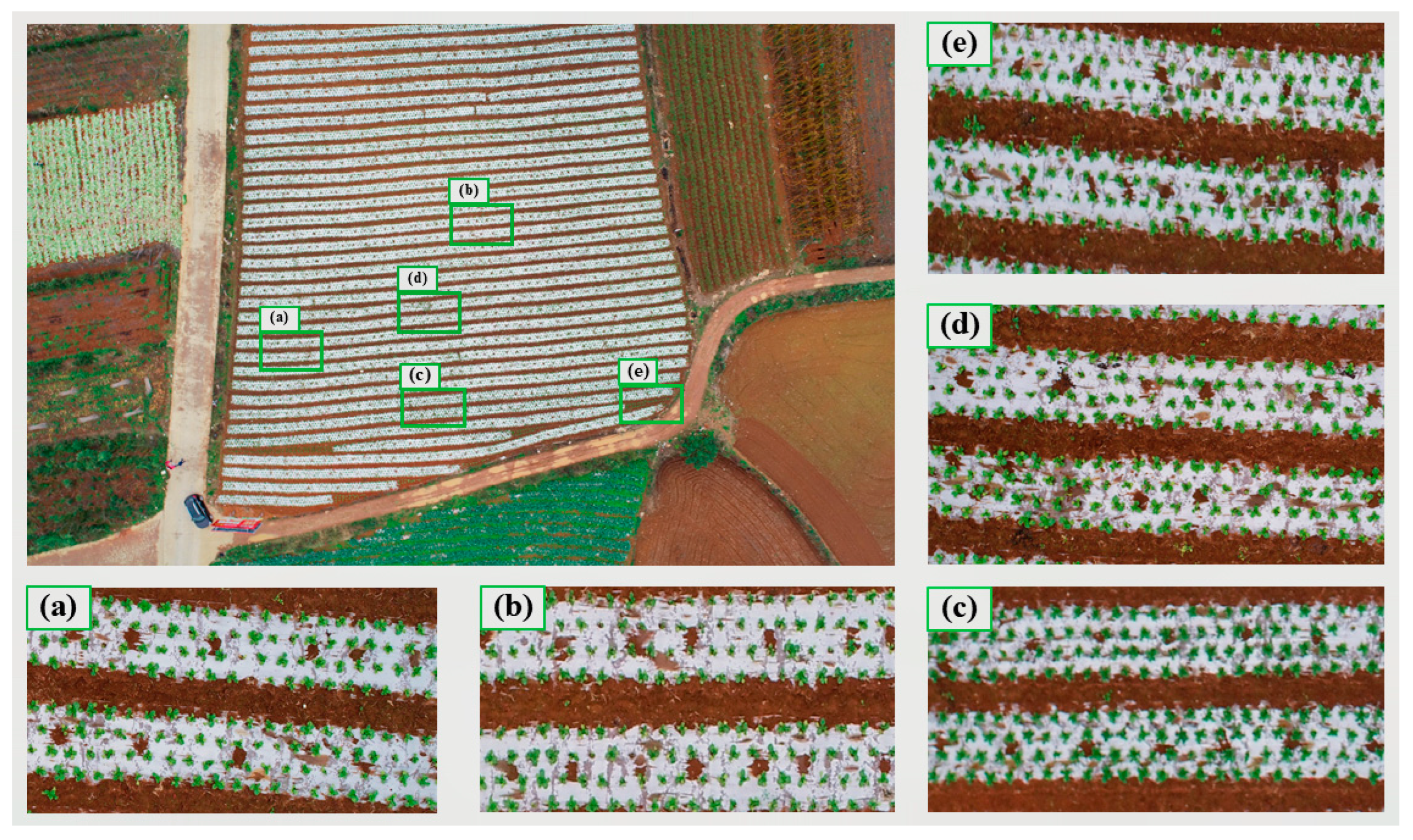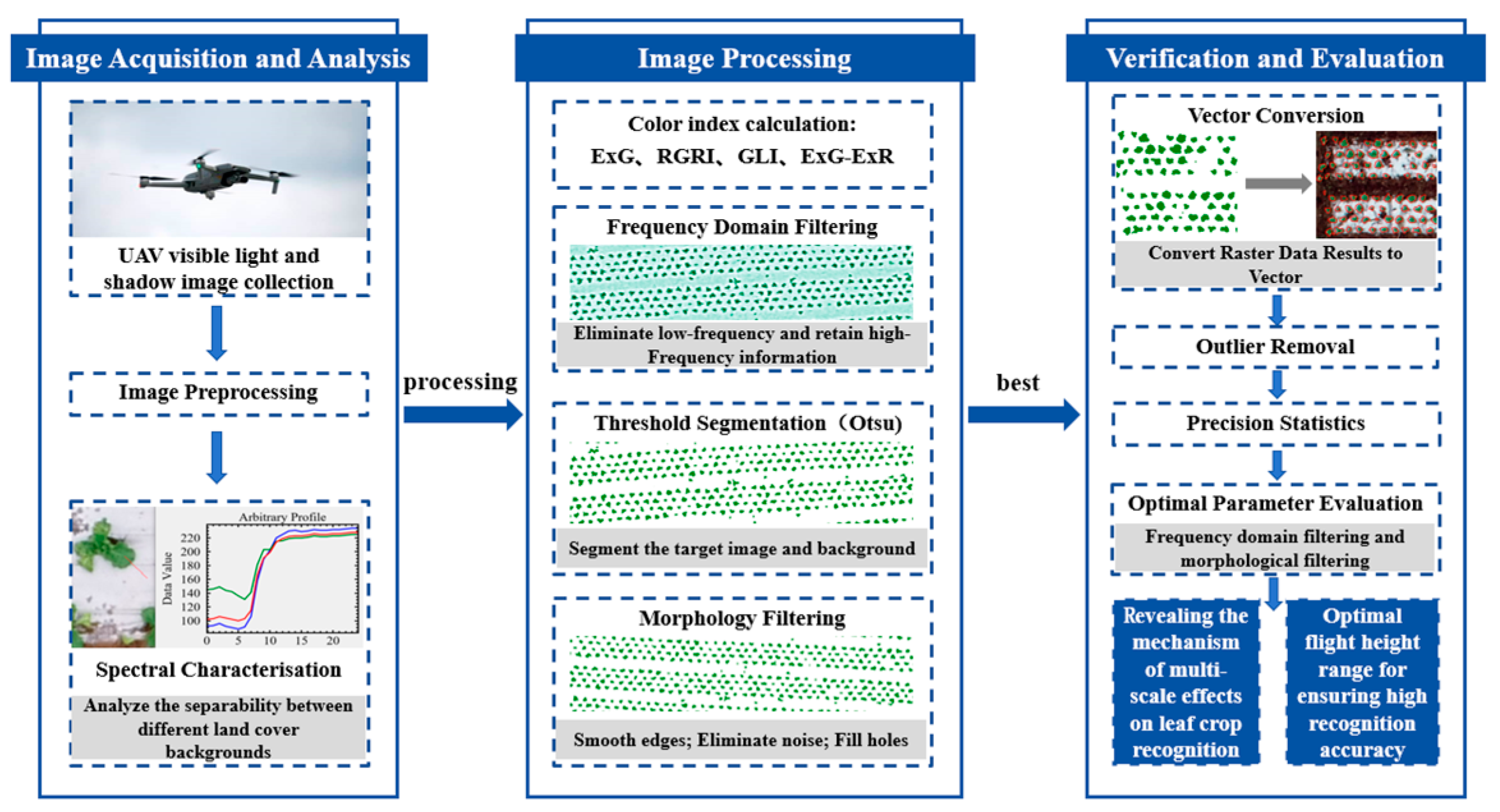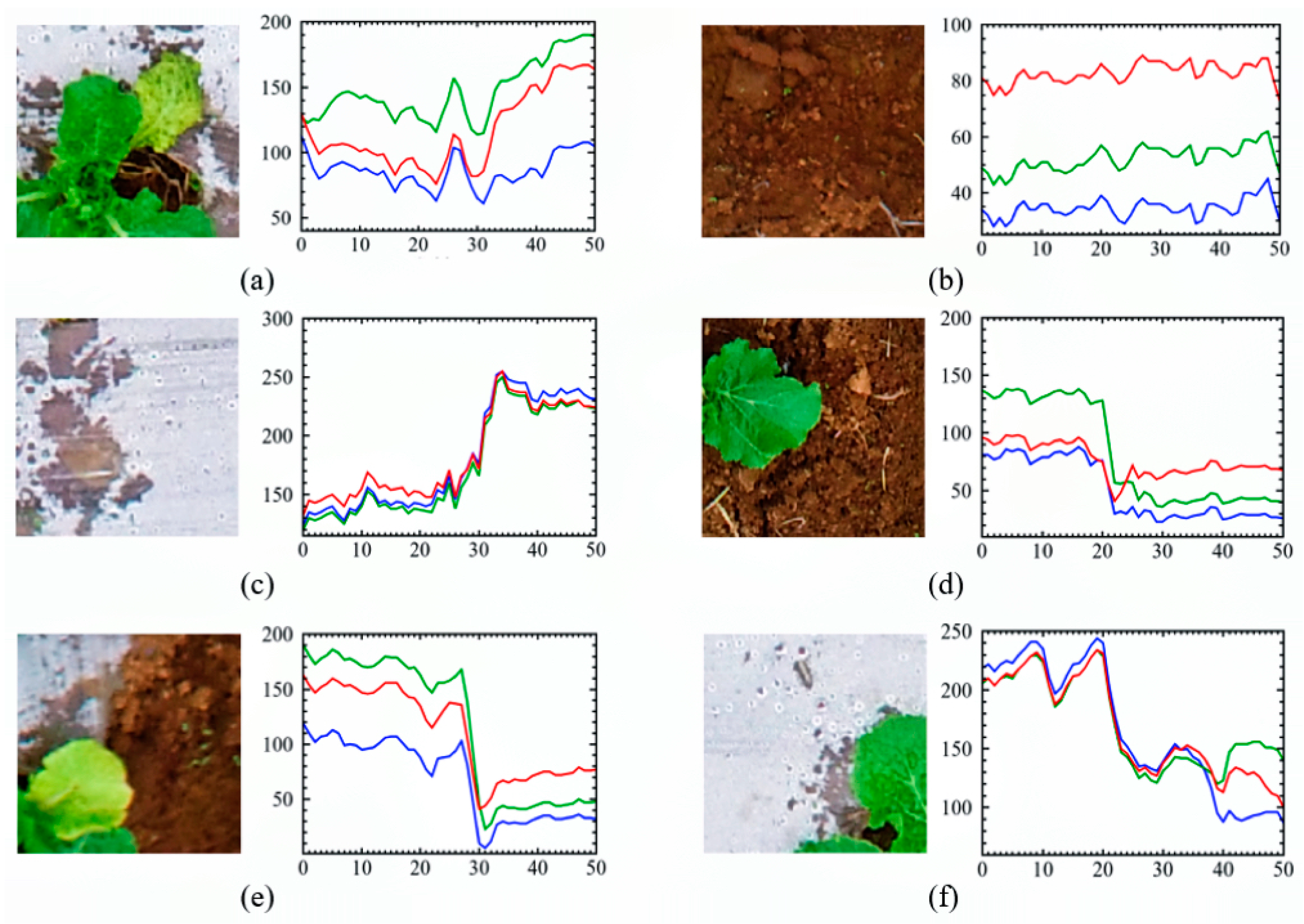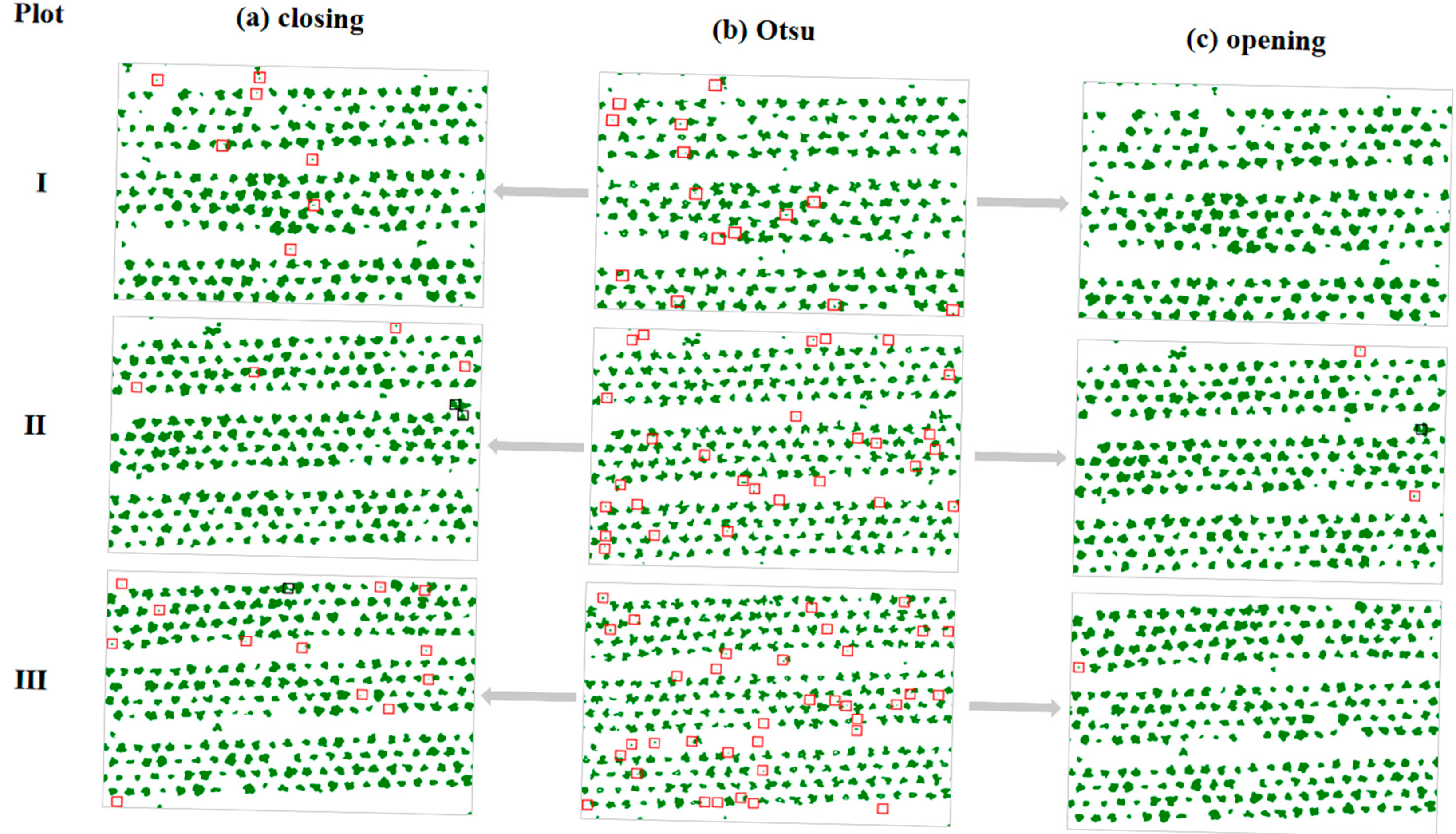Influence of Spatial Scale Effect on UAV Remote Sensing Accuracy in Identifying Chinese Cabbage (Brassica rapa subsp. Pekinensis) Plants
Abstract
:1. Introduction
2. Materials and Methods
2.1. Study Area
2.2. Data Acquisition and Processing
2.3. Research Method
2.3.1. Vegetation Color Index
2.3.2. Image Frequency Domain Filtering
2.3.3. Image Thresholding Segmentation
2.3.4. Morphological Filtering
2.3.5. Precision Evaluation
3. Results and Analysis
3.1. Image RGB Value Extraction and Analysis
3.2. Comparison of Color Index Calculation Results
- (1)
- In the case of multiple overlapping Chinese cabbage leaves, the performance of the ExG and ExG-ExR is superior to that of RGRI and GLI. However, the results for the ExG-ExR show that the edge information is not clear enough, with connected edges between plants. In contrast, the ExG has clear edges, successfully eliminating background leakage components, while enhancing other crops and weeds around the planting area and providing better separation from the soil. Images processed with the ExG Index can retain information about Chinese cabbage plants relatively well, but there is still some noise and minor background leakage components.
- (2)
- In the calculation results of RGRI, there is poor separability between individual plants, as well as between plants and soil or mulch. Observations indicate that the edges of individual plants exhibit an expansion phenomenon. Furthermore, when water droplets are attached to the mulch, the background leakage issue becomes more severe, leading to further reduced separability between plants and mulch.
- (3)
- The analysis results of GLI indicate that in areas where multiple Chinese cabbage leaves overlap, the separation degree between plants and soil is low, leading to some confusion of background information. Additionally, the clarity of the leaf edges is insufficient, resulting in a low contrast between plants and soil.
3.3. Image Frequency Domain Filtering and Otsu
- (1)
- Images of Chinese cabbage at altitudes of 20 m to 40 m are not suitable for Otsu’s method after frequency domain filtering. The images segmented using frequency domain filtering exhibit large areas of salt-and-pepper noise, with numerous holes in the center of the plants and unclear edges. Performing threshold segmentation based on the ExG better captures the edge information of the Chinese cabbage target.
- (2)
- Images of Chinese cabbage at 50 m flight altitude are suitable for Otsu after high-pass processing. Compared with threshold segmentation based on the ExG, the results after high-pass processing can better improve the separability between plants and have less salt-and-pepper noise. However, when performing threshold segmentation on the basis of Gaussian high-pass processing, a large amount of salt-and-pepper noise occurs, leading to poor separability between plants and the background.
- (3)
- Chinese cabbage images captured at an altitude of 60 m to 70 m are suitable for threshold segmentation based on Gaussian high-pass processing. After threshold segmentation based on high-pass processing, the identified targets are highly confused with the background, and the separability between plants is poor, which is not conducive to the identification and extraction of cabbage targets. In contrast, compared to images segmented after processing with the ExG, images segmented after Gaussian high-pass processing show higher separation between plants, which is beneficial in improving recognition accuracy.
- (4)
- As the shooting altitude of the drone relative to the ground increases, the alignment of the processed image results with the edges of the plants gradually decreases, and the separation between the plants also decreases correspondingly. Within the altitude range of 20 m to 50 m, the optimal convolution kernel size for frequency domain filtering is “19 × 19” or “21 × 21”. As the altitude increases, the optimal size of the convolution kernel also increases.
3.4. Comparison of Morphological Filtering Processing Results
3.5. Accuracy Verification
4. Discussion
4.1. Effect of Different Flight Altitudes on Recognition Accuracy
4.2. Effect of Frequency Domain Filtering Processing on Recognition Accuracy on Different Scales
4.3. Effect of Morphological Filtering Processing on Recognition Accuracy at Different Scales
4.4. Shortcomings and Prospects
- (1)
- In this study, the cultivation and management of Chinese cabbage were relatively standardized. Future research could focus on more complex field management environments, including identification needs under seasonal changes and climate impacts, to enhance the applicability of the proposed methods. Additionally, it is recommended that recognition studies be conducted in multi-crop environments beyond Chinese cabbage, as this would help to improve the universality of this method and provide reliable data support for a broader range of agricultural applications.
- (2)
- The background planting structure of the study area was relatively simple, lacking the interference of complex features and thus resulting in fewer interference factors during recognition. At the same time, the data used only represent a single growth period for the crop. In subsequent research, attention should be paid to recognition and extraction across multiple growth periods, as well as applications in complex planting structures and diverse background environments. Furthermore, methods to improve plant separability in cases of overlapping leaves of multiple Chinese cabbage plants need to be further explored.
- (3)
- The exploration of combining neural network models (such as YOLO) with this method will help to optimize the recognition efficiency, enabling real-time detection in video streams or high-frequency monitoring and thereby enhancing the applicability and real-time capabilities of this method.
5. Conclusions
- (1)
- Recognition accuracy of multi-scale images: Multi-scale images at different resolutions exhibit varying recognition accuracies, and optimizing plant recognition is feasible. For instance, under conditions of overlapping leaves, the Excess Green Index demonstrates better separation capability. Different spatial resolutions require different types of filtering and convolution kernel sizes, which also affects the effectiveness of threshold segmentation. As the spatial resolution of the imagery decreases, the optimal window size for morphological filtering also decreases. Simultaneously, as the window size increases, the number of missed recognitions in images of different spatial resolutions increases, while the number of misidentifications decreases.
- (2)
- Optimal flight altitude: Flight altitudes between 30 m and 50 m can achieve better recognition results. This altitude ensures sufficient resolution to meet recognition demands while maintaining a high operational efficiency within the field of view, balancing recognition accuracy and coverage efficiency.
- (3)
- Future research directions: The data collection conditions in this study are relatively ideal, and the impact of complex environments on recognition accuracy has not been considered. Future research could test and enhance this method in more complex backgrounds, during different growth stages, and across larger planting areas, while exploring how to ensure consistency in recognition effects under different hardware conditions.
Author Contributions
Funding
Institutional Review Board Statement
Data Availability Statement
Conflicts of Interest
References
- National Bureau of Statistics. Available online: https://www.stats.gov.cn/sj/ (accessed on 6 October 2024).
- Pathak, H.S.; Brown, P.; Best, T. A Systematic Literature Review of the Factors Affecting the Precision Agriculture Adoption Process. Precis. Agric. 2019, 20, 1292–1316. [Google Scholar] [CrossRef]
- Pierce, F.J.; Nowak, P. Aspects of Precision Agriculture. In Advances in Agronomy; Elsevier: Amsterdam, The Netherlands, 1999; Volume 67, pp. 1–85. [Google Scholar]
- Chen, X.; Shi, Y.X.; Li, X. Research on Recognition Method of Chinese Cabbage Growth Periods Based on Swin Transformer and Transfer Learning. Appl. Eng. Agric. 2023, 39, 381–390. [Google Scholar] [CrossRef]
- Zheng, J.J.; Lan, Y.B.; Xiong, W.J.; Li, S.; Yang, R.N.; Dong, X. Identification method of Pak choi pests and diseases based on improved YOLOv5s. Trans. Chin. Soc. Agric. Eng. 2024, 40, 124–133. [Google Scholar]
- Asano, M.; Onishi, K.; Fukao, T. Robust Cabbage Recognition and Automatic Harvesting under Environmental Changes. Adv. Robot. 2023, 37, 960–969. [Google Scholar] [CrossRef]
- Jiang, P.; Qi, A.; Zhong, J.; Luo, Y.H.; Hu, W.W.; Shi, Y.X.; Liu, T. Field Cabbage Detection and Positioning System Based on Improved YOLOv8n. Plant Methods 2024, 20, 96. [Google Scholar] [CrossRef]
- Aguilar-Ariza, A.; Ishii, M.; Miyazaki, T.; Saito, A.; Khaing, H.P.; Phoo, H.W.; Kondo, T.; Fujiwara, T.; Guo, W.; Kamiya, T. UAV-Based Individual Chinese Cabbage Weight Prediction Using Multi-Temporal Data. Sci. Rep. 2023, 13, 20122. [Google Scholar] [CrossRef]
- Luo, W.; Du, Y.Z.; Zhang, H.L. Discrimination of Varieties of Cabbage with Near Infrared Spectra Based on Principal Component Analysis and Successive Projections Algorithm. Spectrosc. Spectr. Anal. 2016, 36, 3536–3541. [Google Scholar]
- Jiang, A.; Ding, L.; Song, E.Z.; Shao, G.C.; Wang, Y.; Lu, J. UAV-based Multispectral Multi-temporal Chard SPAD Monitoring Study. China Rural. Water Hydropower 2024, 6, 193–202. [Google Scholar]
- Dong, M.; Zhang, Y.; Zhang, X.X.; Zhu, J.W.; Yang, W.P. The research of extracting the characteristic wavebands for pakchoi applying for ABS algorithm based on the LCTF imaging techniques. Opt. Instrum. 2016, 38, 243–247. [Google Scholar]
- Ji, J.C.; Zhao, Y.; Zou, X.J.; Xuan, K.F.; Wang, W.P.; Liu, J.L.; Li, X.P. Advancement in Application of UAV Remote Sensing to Monitoring of Farmlands. Acta Pedol. Sin. 2019, 56, 773–784. [Google Scholar]
- Yao, L.M.; Li, M.; Xie, J.X.; Sun, X. Application of UAV Remote Sensing Technology in Crop Breeding. Hunan Agric. Sci. 2020, 11, 108–112. [Google Scholar]
- Zhang, H.D.; Wang, L.Q.; Tian, T.; Yin, J.H. A Review of Unmanned Aerial Vehicle Low-Altitude Remote Sensing (UAV-LARS) Use in Agricultural Monitoring in China. Remote Sens. 2021, 13, 1221. [Google Scholar] [CrossRef]
- Eladl, S.G.; Haikal, A.Y.; Saafan, M.M.; ZainEldin, H.Y. A Proposed Plant Classification Framework for Smart Agricultural Applications Using UAV Images and Artificial Intelligence Techniques. Alex. Eng. J. 2024, 109, 466–481. [Google Scholar] [CrossRef]
- Anderegg, J.; Tschurr, F.; Kirchgessner, N.; Treier, S.; Graf, L.V.; Schmucki, M.; Caflisch, N.; Minguely, C.; Streit, B.; Walter, A. Pixel to Practice: Multi-Scale Image Data for Calibrating Remote-Sensing-Based Winter Wheat Monitoring Methods. Sci. Data 2024, 11, 1033. [Google Scholar] [CrossRef] [PubMed]
- Li, C.M.; Teng, X.; Tan, Y.; Zhang, Y.; Zhang, H.C.; Xiao, D.; Luo, S.J. Spatio-Temporal Mapping of Leaf Area Index in Rice: Spectral Indices and Multi-Scale Texture Comparison Derived from Different Sensors. Front. Plant Sci. 2024, 15, 1445490. [Google Scholar] [CrossRef]
- Yang, G.F.; He, Y.; Feng, X.P.; Li, X.Y.; Zhang, J.N.; Yu, Z.Y. Methods and New Research Progress of Remote Sensing Monitoring of Crop Disease and Pest Stress Using Unmanned Aerial Vehicle. Smart Agric. 2022, 4, 1–16. [Google Scholar]
- Song, Y.; Chen, B.; Wang, Q.; Su, W.; Sun, L.X.; Zhao, J.; Han, H.Y.; Wang, F.Y. Research advances of crop diseases and insect pests monitoring by unmanned aerial vehicle remote sensing. Cotton Sci. 2021, 33, 291–306. [Google Scholar]
- Zhang, X.; Zhang, F.; Qi, Y.X.; Deng, L.F.; Wang, X.L.; Yang, S.T. New Research Methods for Vegetation Information Extraction Based on Visible Light Remote Sensing Images from an Unmanned Aerial Vehicle (UAV). Int. J. Appl. Earth Obs. Geoinf. 2019, 78, 215–226. [Google Scholar] [CrossRef]
- Chen, J.F.; Zhao, L.; Yue, Y.K.; Fu, H.Y.; Xu, M.Z.; Zhang, L.; Yang, R.F.; Cui, G.X.; She, W. Research Progress of UAV Multispectral Remote Sensing Application in Crop Growth Monitoring. Crop Res. 2022, 36, 391–395. [Google Scholar]
- Huang, D.H.; Zhou, Z.F.; Wu, Y.; Zhu, M.; Yin, L.J.; Cui, L. Identification of Yam Plants in Karst Plateau Hill Basin Based on Visible Light Images of an Unmanned Aerial Vehicle. Trop. Geogr. 2019, 39, 12. [Google Scholar]
- Zhou, Z.F.; Peng, R.W.; Li, R.S.; Li, Y.Q.; Huang, D.H.; Zhu, M. Remote Sensing Identification and Rapid Yield Estimation of Pitaya Plants in Different Karst Mountainous Complex Habitats. Agriculture 2023, 13, 1742. [Google Scholar] [CrossRef]
- Huang, D.H.; Zhou, Z.F.; Zhang, Z.Z.; Zhu, M.; Yin, L.J.; Peng, R.W.; Zhang, Y.; Zhang, W.H. Recognition and Counting of Pitaya Trees in Karst Mountain Environment Based on Unmanned Aerial Vehicle RGB Images. J. Appl. Rem. Sens. 2021, 15, 0424021–04240224. [Google Scholar] [CrossRef]
- Li, Q.X.; Yan, L.H.; Zhou, Z.F.; Huang, D.H.; Xiao, D.N.; Huang, Y.Y. Study on Tobacco Plant Cross-Level Recognition in Complex Habitats in Karst Mountainous Areas Based on the U-Net Model. J. Indian Soc. Remote Sens. 2024, 52, 2099–2114. [Google Scholar] [CrossRef]
- Huang, Y.Y.; Yan, L.H.; Zhou, Z.F.; Huang, D.H.; Li, Q.X.; Zhang, F.X.M.; Cai, L. Complex Habitat Deconstruction and Low-Altitude Remote Sensing Recognition of Tobacco Cultivation on Karst Mountainous. Agriculture 2024, 14, 411. [Google Scholar] [CrossRef]
- Yang, H.B.; Lan, Y.B.; Lu, L.Q.; Gong, D.C.; Miao, J.C.; Zhao, J. New Method for Cotton Fractional Vegetation Cover Extraction Based on UAV RGB Images. Int. J. Agric. Biol. Eng. 2022, 15, 172–180. [Google Scholar] [CrossRef]
- Böhler, J.E.; Schaepman, M.E.; Kneubühler, M. Crop Classification in a Heterogeneous Arable Landscape Using Uncalibrated UAV Data. Remote Sens. 2018, 10, 1282. [Google Scholar] [CrossRef]
- Kim, D.W.; Yun, H.S.; Jeong, S.J.; Kwon, Y.S.; Kim, S.G.; Lee, W.S.; Kim, H.J. Modeling and Testing of Growth Status for Chinese Cabbage and White Radish with UAV-Based RGB Imagery. Remote Sens. 2018, 10, 563. [Google Scholar] [CrossRef]
- Tian, T.; Zhang, Q. Application Research Progress of Unmanned Aerial Vehicle Remote Sensing in Crop Monitoring. Crops 2020, 5, 1–8. [Google Scholar]
- Li, D.R.; Li, M. Research Advance and Application Prospect of Unmanned Aerial Vehicle Remote Sensing System. Geomat. Inf. Sci. Wuhan Univ. 2014, 39, 505–513+540. [Google Scholar]
- Lu, T.Y.; Gao, M.X.; Wang, L. Crop Classification in High-Resolution Remote Sensing Images Based on Multi-Scale Feature Fusion Semantic Segmentation Model. Front. Plant Sci. 2023, 14, 1196634. [Google Scholar] [CrossRef]
- Yang, G.X.; Li, X.R.; Liu, P.Z.; Yao, X.; Zhu, Y.; Cao, W.X.; Cheng, T. Automated In-Season Mapping of Winter Wheat in China with Training Data Generation and Model Transfer. ISPRS J. Photogramm. Remote Sens. 2023, 202, 422–438. [Google Scholar] [CrossRef]
- Liu, Z.; Liu, D.; Zhu, D.; Zhang, L.; Tong, L. Review on Crop Type Fine Identification and Automatic Mapping Using Remote Sensing. Trans. Chin. Soc. Agric. Mach. 2018, 49. [Google Scholar] [CrossRef]
- Ma, Z.Y.; Wang, G.; Yao, J.R.; Huang, D.Y.; Tan, H.W.; Jia, H.L.; Zou, Z.B. An Improved U-Net Model Based on Multi-Scale Input and Attention Mechanism: Application for Recognition of Chinese Cabbage and Weed. Sustainability 2023, 15, 5764. [Google Scholar] [CrossRef]
- Zhang, C.; Liu, J.J.; Su, W.; Qiao, M.; Yang, J.Y.; Zhu, D.H. Optimal scale of crop classification using unmanned aerial vehicle remote sensing imagery based on wavelet packet transform. Trans. Chin. Soc. Agric. Eng. 2016, 32, 95–101. [Google Scholar]
- Mao, W.H.; Wang, Y.M.; Wang, Y.Q. Real-Time Detection of Between-Row Weeds Using Machine Vision. In Proceedings of the 2003 ASAE Annual Meeting, Las Vegas, NV, USA, 27–30 July 2003; American Society of Agricultural and Biological Engineers: St. Joseph, MI, USA, 2003. [Google Scholar]
- Louhaichi, M.; Borman, M.M.; Johnson, D.E. Spatially Located Platform and Aerial Photography for Documentation of Grazing Impacts on Wheat. Geocarto Int. 2001, 16, 65–70. [Google Scholar] [CrossRef]
- Meyer, G.E.; Neto, J.C. Verification of Color Vegetation Indices for Automated Crop Imaging Applications. Comput. Electron. Agric. 2008, 63, 282–293. [Google Scholar] [CrossRef]
- Woebbecke, D.M.; Meyer, G.E.; Bargen, K.V.; Mortensen, D.A. Color Indices for Weed Identification Under Various Soil, Residue, and Lighting Conditions. Trans. ASAE 1995, 38, 259–269. [Google Scholar] [CrossRef]
- Lv, M. Research of the improved parallel line detection algorithm based on Hough transform. Image Process. Multimed. Technol. 2010, 29, 27–29. [Google Scholar]
- Torres-Sánchez, J.; Peña, J.M.; De Castro, A.I.; López-Granados, F. Multi-Temporal Mapping of the Vegetation Fraction in Early-Season Wheat Fields Using Images from UAV. Comput. Electron. Agric. 2014, 103, 104–113. [Google Scholar] [CrossRef]
- Tavares, J.M.R.S.; Jorge, R.M.N. Advances in Computational Vision and Medical Image Processing; Springer: Dordrecht, The Netherlands, 2009; Volume 13. [Google Scholar]
- Sahoo, P.K.; Soltani, S.; Wong, A.K.C. A Survey of Thresholding Techniques. Comput. Vis. Graph. Image Process. 1988, 41, 233–260. [Google Scholar] [CrossRef]
- Zheng, X.L.; Zhang, X.F.; Cheng, J.Y.; Ren, X. Using the multispectral image data acquired by unmanned aerial vehicle to build an estimation model of the number of seedling stage cotton plants. J. Image Graph. 2020, 25, 520–534. [Google Scholar]
- Zhou, J.F.; Khot, L.R.; Boydston, R.A.; Miklas, P.N.; Porter, L.D. Low Altitude Remote Sensing Technologies for Crop Stress Monitoring: A Case Study on Spatial and Temporal Monitoring of Irrigated Pinto Bean. Precis. Agric. 2018, 19, 555–569. [Google Scholar] [CrossRef]
- Ding, L.L.; Li, Q.Z.; Du, X.; Tian, Y.C.; Yuan, C. Vegetation extraction method based on color indices from UAV images. Remote Sens. Land Resour. 2016, 28, 78–86. [Google Scholar]
- Li, J.Y.; Zhang, W.; Kang, Y.; Xu, X.Y.; Qi, L.Q.; Shi, W.Q. Research on soybean seedling number estimation based on UAV remote sensing technology. J. Chin. Agric. Mech. 2022, 43, 83–89. [Google Scholar]
- Huang, D.H.; Zhou, Z.F.; Zhang, Z.Z.; Zhu, M.; Peng, R.W.; Zhang, Y.; Li, Q.X.; Xiao, D.N.; Hu, L.W. Extraction of Agricultural Plastic Film Mulching in Karst Fragmented Arable Lands Based on Unmanned Aerial Vehicle Visible Light Remote Sensing. J. Appl. Rem. Sens. 2022, 16, 036511. [Google Scholar] [CrossRef]
- Cui, S.Y.; Yan, Q.; Reinartz, P. Complex Building Description and Extraction Based on Hough Transformation and Cycle Detection. Remote Sens. Lett. 2012, 3, 151–159. [Google Scholar] [CrossRef]
- Chen, M.T.; Yan, D.M.; Wang, G. Algorithm of high-resolution remote sensing image matching based on Harris corner and SlFT descriptor. J. Image Graph. 2012, 17, 1453–1459. [Google Scholar]
- Tao, C.; Tan, Y.H.; Cai, H.J.; Du, B.; Tian, J.W. Object-oriented Method of Hierarchical Urban Building Extraction from High-resolution Remote-Sensing lmagery. Acta Geod. Cartogr. Sin. 2010, 39, 39–45. [Google Scholar]
- Kumar, T.; Verma, K. A Theory Based on Conversion of RGB Image to Gray Image. Int. J. Comput. Appl. 2010, 7, 5–12. [Google Scholar] [CrossRef]
- Zheng, S.Y.; Hai, Y.; He, M.Q.; Wang, J.X. Construction of Vegetation Index in Visible Light Band of GF-6 Image with Higher Discrimination. Spectrosc. Spectr. Anal. 2023, 43, 3509–3517. [Google Scholar]
- Liu, S.; Zhu, H. Object-oriented land use classification based on ultra-high resolution images taken by unmanned aerial vehicle. Trans. Chin. Soc. Agric. Eng. 2020, 36, 87–94. [Google Scholar]
- Anderson, K.; Gaston, K.J. Lightweight Unmanned Aerial Vehicles Will Revolutionize Spatial Ecology. Front. Ecol. Environ. 2013, 11, 138–146. [Google Scholar] [CrossRef]
- Colomina, I.; Molina, P. Unmanned Aerial Systems for Photogrammetry and Remote Sensing: A Review. ISPRS J. Photogramm. Remote Sens. 2014, 92, 79–97. [Google Scholar] [CrossRef]
- Elhadary, A.; Rabah, M.; Taha, E.G.M.A. The Influence of Flight Height and Overlap on UAV Imagery over Featureless Surfaces and Constructing Formulas Predicting the Geometrical Accuracy. NRIAG J. Astron. Geophys. 2022, 11, 210–223. [Google Scholar] [CrossRef]
- He, Y.; Du, X.Y.; Zheng, L.Y.; Zhu, J.P.; Cen, H.Y.; Xu, L.J. Effects of UAV flight height on estimated fractional vegetation cover and vegetation index. Trans. Chin. Soc. Agric. Eng. 2022, 38, 63–72. [Google Scholar]
- Gonzalez, R.C.; Woods, R.E. Digital Image Processing, 3rd ed.; Prentice Hall: Upper Saddle River, NJ, USA, 2008. [Google Scholar]
- Theodoridis, S.; Koutroumbas, K. Pattern Recognition, 4th ed.; Publishing House of Electronics Industry: Beijing, China, 2016. [Google Scholar]
- Kittler, J.; Illingworth, J. On Threshold Selection Using Clustering Criteria. IEEE Trans. Syst. Man Cybern. 1985, 5, 652–655. [Google Scholar] [CrossRef]
- Yang, Y.; Zhao, Q.H. Multi-level threshold segmentation of high-resolution panchromatic remote sensing imagery. Opt. Precis. Eng. 2020, 28, 2370–2383. [Google Scholar] [CrossRef]



 The red box indicates the noise of the image;
The red box indicates the noise of the image;  the black box indicates the conjoined area between plants.
the black box indicates the conjoined area between plants.
 The red box indicates the noise of the image;
The red box indicates the noise of the image;  the black box indicates the conjoined area between plants.
the black box indicates the conjoined area between plants.
| Type | Growth Situation | Image | ExG | RGRI | GLI | ExG-ExR |
|---|---|---|---|---|---|---|
| I | Single plant |  |  |  |  |  |
| II | Two overlapping leaves |  |  |  |  |  |
| III | Three overlapping leaves |  |  |  |  |  |
| Flight Altitude | ExG | Otsu (ExG) | ExG→HP | Otsu (HP) | ExG→GHP | Otsu (GHP) |
|---|---|---|---|---|---|---|
| 20 m |  |  |  19 × 19 |  |  19 × 19 |  |
| 30 m |  |  |  21 × 21 |  |  21 × 21 |  |
| 40 m |  |  |  21 × 21 |  |  21 × 21 |  |
| 50 m |  |  |  19 × 19 |  |  19 × 19 |  |
| 60 m |  |  |  65 × 65 |  |  65 × 65 |  |
| 70 m |  |  |  67 × 67 |  |  67 × 67 |  |
| Flight Altitude (m) | Window Size | BF (%) | MF (%) | DP (%) | QP (%) |
|---|---|---|---|---|---|
| 20 | 3 × 3 | 6.36 | 0.21 | 99.79 | 93.83 |
| 5 × 5 | 5.93 | 0.47 | 99.53 | 93.99 | |
| 7 × 7 | 5.17 | 1.42 | 98.60 | 93.82 | |
| 9 × 9 | 2.62 | 3.00 | 97.08 | 94.67 | |
| 30 | 3 × 3 | 2.48 | 0.14 | 99.86 | 97.44 |
| 5 × 5 | 0.85 | 0.52 | 99.48 | 98.65 | |
| 7 × 7 | 0.12 | 2.69 | 97.38 | 97.26 | |
| 9 × 9 | 0.01 | 6.23 | 94.13 | 94.12 | |
| 40 | 3 × 3 | 0.57 | 0.27 | 99.73 | 99.17 |
| 5 × 5 | 0.07 | 1.35 | 98.67 | 98.60 | |
| 7 × 7 | 0.00 | 5.15 | 95.10 | 95.10 | |
| 9 × 9 | 0.00 | 18.75 | 84.21 | 84.21 | |
| 50 | 3 × 3 | 1.01 | 0.09 | 99.91 | 98.91 |
| 5 × 5 | 0.07 | 1.70 | 98.33 | 98.27 | |
| 7 × 7 | 0.02 | 20.65 | 82.88 | 82.87 | |
| 9 × 9 | 0.00 | 394.44 | 20.22 | 20.22 | |
| 60 | 3 × 3 | 0.47 | 0.13 | 99.87 | 99.40 |
| 5 × 5 | 0.00 | 2.64 | 97.43 | 97.43 | |
| 7 × 7 | 0.00 | 31.55 | 76.02 | 76.02 | |
| 9 × 9 | 0.00 | 609.38 | 14.10 | 14.10 | |
| 70 | 3 × 3 | 0.28 | 0.61 | 99.40 | 99.12 |
| 5 × 5 | 0.01 | 6.16 | 94.19 | 94.18 | |
| 7 × 7 | 0.00 | 78.59 | 56.00 | 56.00 | |
| 9 × 9 | 0.00 | 2932.03 | 3.30 | 3.30 |
Disclaimer/Publisher’s Note: The statements, opinions and data contained in all publications are solely those of the individual author(s) and contributor(s) and not of MDPI and/or the editor(s). MDPI and/or the editor(s) disclaim responsibility for any injury to people or property resulting from any ideas, methods, instructions or products referred to in the content. |
© 2024 by the authors. Licensee MDPI, Basel, Switzerland. This article is an open access article distributed under the terms and conditions of the Creative Commons Attribution (CC BY) license (https://creativecommons.org/licenses/by/4.0/).
Share and Cite
Du, X.; Zhou, Z.; Huang, D. Influence of Spatial Scale Effect on UAV Remote Sensing Accuracy in Identifying Chinese Cabbage (Brassica rapa subsp. Pekinensis) Plants. Agriculture 2024, 14, 1871. https://doi.org/10.3390/agriculture14111871
Du X, Zhou Z, Huang D. Influence of Spatial Scale Effect on UAV Remote Sensing Accuracy in Identifying Chinese Cabbage (Brassica rapa subsp. Pekinensis) Plants. Agriculture. 2024; 14(11):1871. https://doi.org/10.3390/agriculture14111871
Chicago/Turabian StyleDu, Xiandan, Zhongfa Zhou, and Denghong Huang. 2024. "Influence of Spatial Scale Effect on UAV Remote Sensing Accuracy in Identifying Chinese Cabbage (Brassica rapa subsp. Pekinensis) Plants" Agriculture 14, no. 11: 1871. https://doi.org/10.3390/agriculture14111871
APA StyleDu, X., Zhou, Z., & Huang, D. (2024). Influence of Spatial Scale Effect on UAV Remote Sensing Accuracy in Identifying Chinese Cabbage (Brassica rapa subsp. Pekinensis) Plants. Agriculture, 14(11), 1871. https://doi.org/10.3390/agriculture14111871







